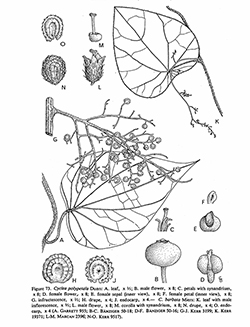e-Flora of Thailand
Volume 5 > Part 3 > Year 1991 > Page 328 > Menispermaceae > Cyclea
4. Cyclea barbata Mierswfo-0000632046
(Ann. Mag. Nat. Hist. Ser. 3, 18: 19. 1866 nomen), Contrib. Bot. 3: 237. 1871; Diels in Pflanzenr. Menisp.: 314. 1910; Burk., Diet. 1: 721. 1935; Gagnep. in Suppl. Fl. Gén. I.-C. 1: 139. 1938, pro parte; Forman, Kew Bull. 14: 77. 1960; in Fl. Males. I. 10: 242. 1986; Kew Bull. 43: 389. 1988.
Accepted Name : This is currently accepted.
Synonyms & Citations :
Description : Slender climber, up to ca 5 m; roots thick and long; stems herbaceous orwoody, hispid when young, later glabrescent. Leaves ovate, deltoid-ovate or broadly ovate, 6–17.5 by 4–12.5 cm, base slightly emarginate, truncate or roun-ded, apex acutely acuminate to obtuse, with a finely mucronate acumen, margin often hispid, hispid to subglabrous above, puberulous to tomentose below, occasionally hispid along nerves, papyraceous; petioles hispid, 3–6.5 cm, attached 6–25 mm above the basic of lamina. Male inforescencas axillary or cauliflorous, 7–12(–30) by 0.5–4(–12) cm, puberulous; flowers in spaced, dense, subca-pitate, hairy clusters, borne on short lateral branches, 1–4(–7) cm. Male flowers with pedicels, 1–2 mm; calyx greenish, campanulate, pilose, 1.5–2 mm long; lobes 4 (or 5), triangular, about half the length of tube; corolla gamo-petalous, cupulaI, margin truncate or obtusely lobed, 0.75 mm long, glabrous; synandrium 1.5–2 mm long, usually exserted. Female inflorescences similar to male but usually broader, 11–19 by 3–7 cm. Female flowers sessile in dense heads; sepals 2, rhomboid to obovate, 0.5 mm long and broad, pilose on outer surface; petals 2, ± reniform, opposite to and much broader than sepals, 0.5 by 0.75–1 mm, glabrous; carpels 1 mm long, densely pilose; stigma 3-laciniate. Drupes white, obliquely obovate to rounded in outline, 5–7 by 4–5.5 mm, puberulous; endocarp bearing 4 dorsal rows of papilliform tubercles, and a lateral subentire curved ridge bordering the condyle on each side.
Thailand : Widespread in Northern, South-Eastern, South-Western and Peninsular regions.
Distribution : Assam, Burma (type), S Vietnam, Sumatra, Java.
Ecology : In evergreen, bamboo and deciduous forests, also in scrub, sometimes on limestone, up to 1,100 m alt. Flowering: February–November; fruiting: November–February (–April).
Vernacular : Krung badan (กรุงบาดาล)(Southeastern); krung khamao (กรุงเขมา)(Peninsular).
Uses: Fruits used to treat malaria.

